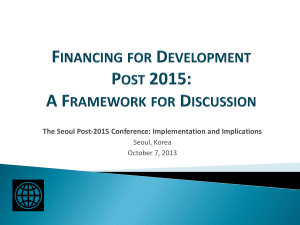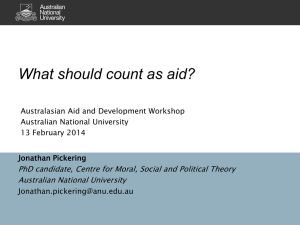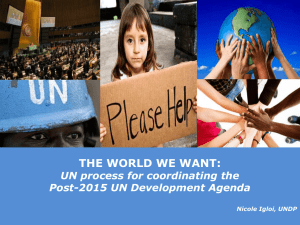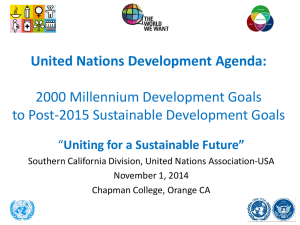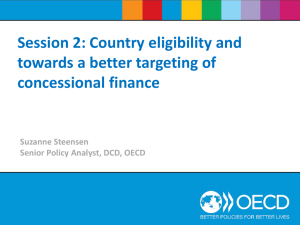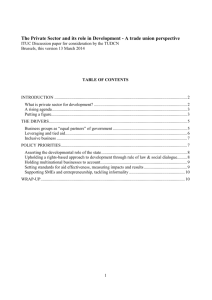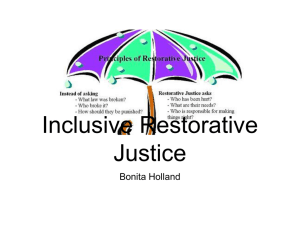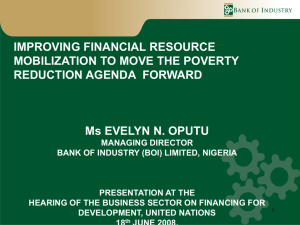Session 9: Post 2015 - International Health Partnership
advertisement
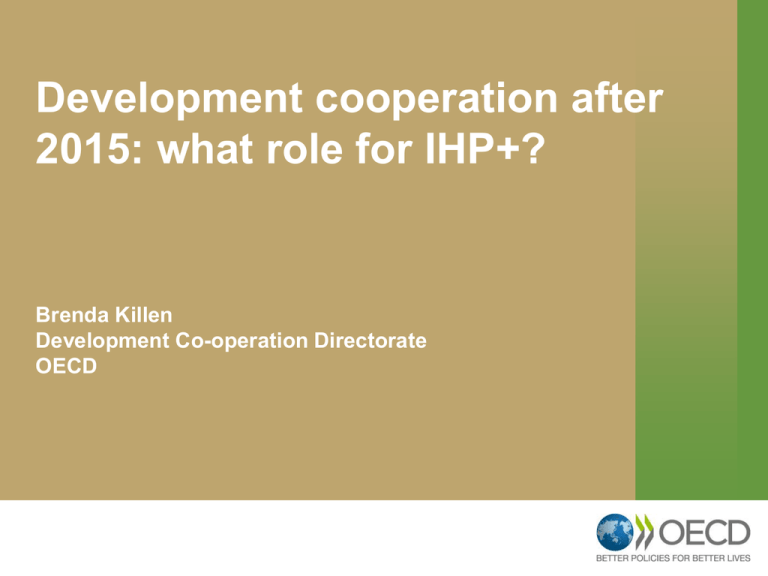
Development cooperation after 2015: what role for IHP+? Brenda Killen Development Co-operation Directorate OECD What do we know about the post-2015 agenda? • Broader in scope: – Three pillars of sustainable development: economic , social, environmental – Universal goals for all countries – Global public goods as well as national development challenges • More ambitious vision: – Zero-based goals: e.g. ending poverty and hunger – More holistic vision, focused on overall development outcomes – Every success will make the remaining mission harder to achieve – Goals will act as a global social floor … more complex process! SUSTAINABLE DEVELOPMENT GOALS GOAL 1 GOAL 2 GOAL 3 GOAL 4 GOAL 5 GOAL 6 GOAL 7 GOAL 8 GOAL 9 GOAL 10 GOAL 11 GOAL 12 GOAL 13 GOAL 14 GOAL 15 GOAL 16 GOAL 17 End poverty in all its forms everywhere End hunger, achieve food security and improved nutrition and promote sustainable agriculture Ensure healthy lives and promote well-being for all at all ages Ensure inclusive and equitable quality education and promote lifelong learning opportunities for all Achieve gender equality and empower all women and girls Ensure availability and sustainable management of water and sanitation for all Ensure access to affordable, reliable, sustainable and modern energy for all Promote sustained, inclusive and sustainable economic growth, full and productive employment and decent work for all Build resilient infrastructure, promote inclusive and sustainable industrialization and foster innovation Reduce inequality within and among countries Make cities and human settlements inclusive, safe, resilient and sustainable Ensure sustainable consumption and production patterns Take urgent action to combat climate change and its impacts* Conserve and sustainably use the oceans, seas and marine resources for sustainable development Protect, restore and promote sustainable use of terrestrial ecosystems, sustainably manage forests, combat desertification, and halt and reverse land degradation and halt biodiversity loss Promote peaceful and inclusive societies for sustainable development, provide access to justice for all and build effective, accountable and inclusive institutions at all levels Strengthen the means of implementation and revitalize the global partnership for sustainable development SUSTAINABLE DEVELOPMENT GOALS More focus on implementation and accountability • Not just about goals: the September 2015 summit will adopt an entire package: – Political declaration; – Sustainable Development Goals, targets and indicators; – Means of Implementation and a new Global Partnership; – Framework for monitoring and review of implementation. • This is where attention will increasingly turn over the next several months: to the how of the post-2015 framework in addition to the what. What will it take to deliver the post-2015 framework? • Financing – development and climate – will be critical, but not sufficient • New actors and instruments, new financing landscape • Other means of implementation: trade, technology transfer, technical advice, policy support, etc. • Focus on inclusive growth • Partnerships and coalitions Today’s development finance landscape More diversification and changing relative importance of financial flows to developing countries Today’s development finance landscape Recipients: reliance on ODA varies across developing countries and those most in need are starting to receive less ODA Composition of external finance in LDCs and other countries, 2012 ODA growth is accelerating for MICs.. …but not for LDCs and fragile states Today’s development finance landscape New actors and instruments Ensuring the right incentives • Work to assess and measure resources beyond ODA should not be used by donors to back away from existing commitments, including the U.N. target of 0.7% ODA/GNI • ODA is critically important going forward, especially for LDCs and fragile states (reverse the downward trend of ODA to LDCs) • Effectively contribute to transparency and accountability for the monitoring of the post-2015 development agenda • In more complex financing landscape, how do we protect the role of aid and make sure it is focused on what it does best? OECD DAC modernisation agenda • Reflect broadening of the global development agenda • Reflect the new complexity of development finance (actors/instruments) • Acknowledge increased diversity of developing countries and provide the right incentives for ODA allocations • Promote international standards for measuring and monitoring the means of the implementation of the SDGs • Increase transparency and accountability of development finance • Goal: maximise overall resource envelope available and make the best of public money for development Partnerships • Inclusive coalitions – multi-stakeholder initiatives, more partnerships with private sector • Shift from ‘implementers to enablers’ • The landscape for cooperation is becoming more complex – but this offers more opportunities to get the right type of support. • OECD hosts various partnerships: International Dialogue on Peacebuilding and Statebuilding, Effective Institutions Platform, PARIS21 • Global Partnership for Effective Development Co-operation: ‘partnerships hub’ for a range of initiatives, including IHP+ So what have we learned? • Post-2015 framework will be more ambitious, requiring more integrated, holistic responses, which will need to be delivered in a more complex landscape. • This tracks with what we’ve learned in health: successful health systems are essential for delivering improved outcomes on overall health and mortality. • No substitute for effective public institutions in protecting the public interest. This means investments in capacity, but also in building trust between state and society. Ebola: failure to invest in health systems What does this mean for IHP+? What does this mean for IHP+? • Developing countries want more policy support to promote inclusive growth, market-like approaches • The seven behaviours – and the Busan principles – are even more important in this context. • Does IHP+ need to re-introduce itself to explain what it brings to the equation to help guide countries, systems, and communities to manage this complexity? Thank you Some Additional Slides External development finance: emerging financial concepts - provider’s perspective External development finance: emerging financial concepts - recipient country’s perspective Ebola: unprecedented crisis Jim Kim on Ebola “[We] must act on the knowledge that weak public health infrastructure, institutions, and systems in many fragile countries are a threat not only to their own citizens but also to their trading partners and the world at large. The enormous economic cost of the current outbreak to the affected countries and the world could have been avoided by prudent ongoing investment in health systems-strengthening.’’
